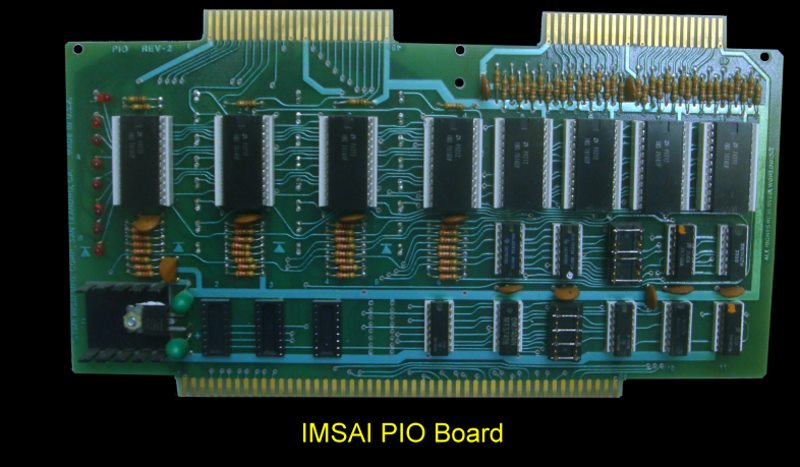
IMSAI - PIO Board
This board is found in almost all the
early IMSAI systems. It is a 4 parallel port I/O board

The PIO 4 board provides for up to four
input and four output ports of eight bits each parallel input and parallel
output. Each input and each output port had its own latch and both input and
output latches were provided with handshaking logic for conventional eight bit
parallel transfers. Connection to the input or output ports is made through
board edge connectors at the top of the board on -10 inch centers and the
fingers will accept the 3M flat cable edge connectors as well as most other .1
inch center-to-center board edge connectors. The handshake logic on any input or
output port will generate an interrupt. The priority level of the interrupt is
selectable. The address of the four ports is four sequential addresses, and
this block of four addresses may be jumper-selected to be any block of four
sequential addresses in the 256 I/O address space. The board may also be
addressed with memory-mapped I/O, in which case normal memory read or write
instructions are used to read or write data to the Input/Output ports. When
using memory-mapped I/O, board addressing is done by selectable jumpers for the
lower byte of address and the upper byte of address is hex FFH. Provision was
made for each of the four output ports to drive eight LED's for a total of 32
on-board LSD's. This feature can be used to provide program-controlled output
for dedicated processor applications of the IMSAI 8080 in which case this PIO
board would be plugged in where the front panel would normally be mounted and a
special photographic mask made to put in front of it with the appropriate
labels for the specific purpose the controller is to be used- The front panel
can still be used during development by plugging it into an extender card in
another slot. The board utilized 6 Intel 8212's.
The LED's are a nice feature on this
board. I use one port to sequentially light up LED's in a bit pattern as my
monitor initializes different components of my S-100 system. Great for debugging
if your system hangs without a working monitor.
The manual for this board can be
obtained here.
Other IMSAI S-100 Boards
4KRAM
8080CPU
EPROM-Programmer
MPU-B
PIC-8 PIO
PROM-4 SIO
VIO
MIO
FDC (FIB/FIM)
This page was last modified
on
01/08/2011


